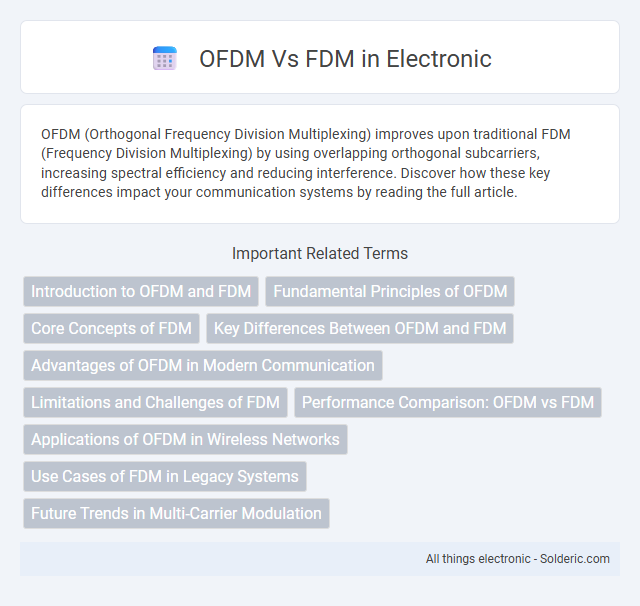OFDM (Orthogonal Frequency Division Multiplexing) improves upon traditional FDM (Frequency Division Multiplexing) by using overlapping orthogonal subcarriers, increasing spectral efficiency and reducing interference. Discover how these key differences impact your communication systems by reading the full article.
Comparison Table
| Feature | OFDM (Orthogonal Frequency Division Multiplexing) | FDM (Frequency Division Multiplexing) |
|---|---|---|
| Definition | Multicarrier modulation technique using orthogonal subcarriers. | Division of bandwidth into non-overlapping frequency bands for multiple signals. |
| Subcarrier Usage | Orthogonal subcarriers overlap in frequency but remain independent. | Non-overlapping, distinct frequency bands assigned to each channel. |
| Spectrum Efficiency | High, due to overlapping orthogonal subcarriers. | Lower, requires guard bands between channels. |
| Complexity | Higher, requires FFT/IFFT processing and synchronization. | Lower, simpler filtering and demodulation. |
| Resistance to Interference | Better, handles frequency selective fading effectively. | Less effective, vulnerable to crosstalk and interference. |
| Applications | Used in Wi-Fi, LTE, DVB-T, 5G. | Used in traditional analog/digital telephony, radio broadcasting. |
| Data Rate | Supports high data rates with adaptive modulation. | Limited by fixed bandwidth allocation. |
| Latency | Moderate, processing overhead may increase latency. | Low, due to simpler modulation. |
Introduction to OFDM and FDM
Orthogonal Frequency Division Multiplexing (OFDM) uses closely spaced orthogonal sub-carriers to transmit data simultaneously, reducing interference and improving spectral efficiency. Frequency Division Multiplexing (FDM) divides the available bandwidth into distinct frequency bands allocated to separate channels, minimizing overlap but with less efficient spectrum usage. OFDM's design enables robust performance in multipath environments, making it ideal for modern wireless communications compared to the traditional FDM approach.
Fundamental Principles of OFDM
Orthogonal Frequency Division Multiplexing (OFDM) utilizes multiple closely spaced orthogonal subcarriers to transmit data simultaneously, minimizing interference and maximizing spectral efficiency compared to Frequency Division Multiplexing (FDM). OFDM's core principle is orthogonality, which ensures that subcarriers do not overlap in frequency domain despite their overlapping spectra, allowing precise separation at the receiver. This technique leverages Fast Fourier Transform (FFT) algorithms for efficient modulation and demodulation, making OFDM highly resilient to multipath fading and inter-symbol interference in wireless communications.
Core Concepts of FDM
Frequency Division Multiplexing (FDM) allocates distinct frequency bands to multiple signals simultaneously, ensuring they do not overlap by incorporating guard bands between channels. This method enables simultaneous transmission over a single communication medium by dividing the total bandwidth into non-interfering frequency slots. Your communication system can benefit from FDM's straightforward implementation in analog transmissions with relatively simple hardware requirements.
Key Differences Between OFDM and FDM
Orthogonal Frequency Division Multiplexing (OFDM) uses orthogonal subcarriers to minimize interference, allowing overlapping frequency bands and improving spectral efficiency, whereas Frequency Division Multiplexing (FDM) assigns non-overlapping frequency bands to each channel, separated by guard bands to prevent crosstalk. OFDM employs digital modulation techniques and FFT algorithms for transmission and reception, which enhances robustness against multipath fading and inter-symbol interference, while FDM relies primarily on analog modulation methods. OFDM is widely used in modern wireless communication systems like LTE and Wi-Fi, offering higher data rates and efficient bandwidth utilization, whereas FDM is commonly found in traditional radio broadcasting and older communication systems.
Advantages of OFDM in Modern Communication
OFDM offers superior spectral efficiency compared to traditional FDM by dividing the available bandwidth into closely spaced orthogonal subcarriers, reducing interference and maximizing data throughput. Its robustness against multipath fading and frequency-selective channels enhances signal quality and reliability in complex environments such as urban or indoor communications. Your communication systems benefit from OFDM's ability to support high data rates and improve bandwidth utilization, making it ideal for modern wireless standards like LTE and Wi-Fi.
Limitations and Challenges of FDM
Frequency Division Multiplexing (FDM) encounters limitations such as spectral inefficiency due to large guard bands needed to prevent channel interference, resulting in wasted bandwidth. It also suffers from susceptibility to crosstalk and intermodulation distortion, which degrade signal quality. Your communication systems may face challenges in scaling and flexibility compared to Orthogonal Frequency Division Multiplexing (OFDM), which offers better spectral efficiency and robustness against frequency-selective fading.
Performance Comparison: OFDM vs FDM
OFDM outperforms FDM by efficiently utilizing the available bandwidth through orthogonal subcarriers, which minimizes inter-channel interference and enhances spectral efficiency. Your communication system benefits from OFDM's robustness against multipath fading and its superior resilience in high-speed data transmission compared to traditional FDM. This performance advantage makes OFDM the preferred choice in modern broadband and wireless networks.
Applications of OFDM in Wireless Networks
OFDM (Orthogonal Frequency Division Multiplexing) is widely used in wireless networks such as LTE, Wi-Fi (IEEE 802.11a/g/n/ac/ax), and 5G due to its ability to efficiently manage multipath interference and high-speed data transmission. FDM (Frequency Division Multiplexing) is simpler and often applied in traditional radio broadcasting but lacks OFDM's robustness in dynamic wireless environments. Your wireless devices benefit from OFDM's superior spectral efficiency and resilience, enabling faster and more reliable communication in congested networks.
Use Cases of FDM in Legacy Systems
FDM (Frequency Division Multiplexing) is widely used in legacy analog communication systems such as traditional radio broadcasting, cable TV distribution, and early telephone networks. These systems allocate distinct frequency bands to separate channels, enabling simultaneous transmission over a single communication medium without interference. Your familiarity with FDM is essential when maintaining or integrating older infrastructure where digital alternatives like OFDM have not been implemented.
Future Trends in Multi-Carrier Modulation
Future trends in multi-carrier modulation emphasize the growing preference for Orthogonal Frequency Division Multiplexing (OFDM) due to its superior spectral efficiency and robustness against multipath interference compared to Frequency Division Multiplexing (FDM). Integrations of advanced techniques like Filter Bank Multicarrier (FBMC) and Universal Filtered Multicarrier (UFMC) aim to address OFDM's limitations in high-mobility and asynchronous scenarios. Emerging 5G and beyond wireless standards leverage these innovations to enhance data rates, reduce latency, and improve overall network reliability.
OFDM vs FDM Infographic

 solderic.com
solderic.com